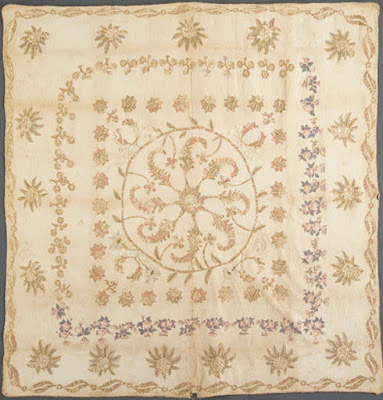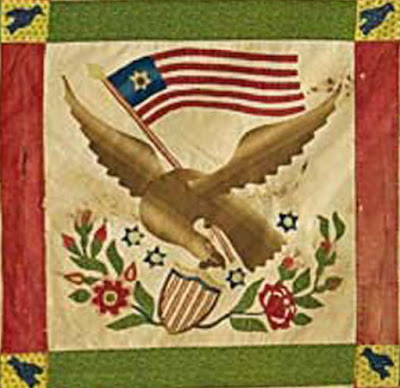Cassandra's Circle Block #1
Washington's Plume by Becky Brown
36"
Our Civil War story begins in 1789, seven decades before that war began, with a moment frozen in American myth. General George Washington rode through Trenton, New Jersey on his way from Virginia to his New York inauguration as first president, a joyous celebration for a new nation. Towns along the route welcomed the hero riding his white horse and none so unforgettably as Trenton.
Jane Hunter Ewing (1768-1831)
by Charles Willson Peale
about the time of Washington's inauguration
Jane Hunter Ewing described the ceremony:
"Ladies was rang’d in a line from the arch along the Bridge and thirteen Girls dress’t in white with Baskets of flowers" threw blossoms at his horse's feet. Washington "Sat on his horse while they sung and then made them a low Bow say’d the Ladies had done them [him] a very great honour."
Over the years various publishers issued prints of the Trenton celebration, a ceremony that struck a chord in a country eager to establish a republican history.
The women and girls were society's elite in the Philadelphia/New Jersey area. Among the young women dressed in white were the wife and daughters of Revolutionary soldier Colonel John Cox, a friend of the General's.
Mary Bowes Cox (1775-1864)
Drawn from an oil painting by Gilbert Stuart
Mary Bowes Cox was about 14 when she portrayed one of the thirteen United States to General Washington's delight. She'd grown up in a lovely Trenton home named Bloomsbury, which still stands as the Trent House, restored to the period when she lived there. Bloomsbury, said to be New Jersey's oldest surviving house, was always her standard of elegance and Mary occasionally irritated her daughter-in-law by bringing up how things were done at Bloomsbury in the old days.
Washington's Plume by Denniele Bohannon
James Chesnut (1773-1866)
Drawn from an oil painting by Gilbert Stuart
Despite post-war poverty the family has hung
on to their Gilbert Stuart portraits of the newlyweds.
In 1796 21-year-old Mary married James Chesnut, a wealthy planter from Camden, South Carolina and lived the rest of her life in the south at Mulberry, the Chesnut family plantation. The unfortunate woman gave birth to fourteen children and lost ten of them before she died at about 80 at Mulberry during the Civil War. She was mother-in-law to Mary Boykin Miller Chesnut who is the Cassandra in our quilt theme Cassandra's Circle.
"I sat all day yesterday with Mrs. Chesnut, she entertaining me with old world, carriage and four, stories of her grandeur in Philadelphia. Then she likes to harangue me as to my troubles. Heaven only knows I try to be patient." Mary Boykin Chesnut, December 8, 1861.Were those troubles the younger Mary's inability to bear children? Miscarriages, a nearly unmentionable subject, may have been the problem.
The two Mary Chesnuts spent much time together at
the family home Mulberry near Camden, South Carolina.
It is sometimes difficult to live with your mother-in-law. The two Marys had much in common, a love of reading and gardens, a sense of elegance and love for James II, the only surviving son. But the younger woman was "a rebel born. My husband's family being equally pledged to the Union party rather exasperated my zeal."
The younger Mary's chief complaint was the elder's refusal to deal with reality in all it's unpleasantness. "She is blind to all but beautiful things, rose-tinted beliefs and pure imagination." His daughter-in-law believed the elder James Chesnut was father to a slave woman's family, a topic never discussed but something that infuriated the younger woman.
"Can I honor what is dishonorable? Rachel and her brood make this place a horrid nightmare to me."
Mulberry in the 1930s
Library of Congress
Historic American Buildings Survey
Their house still stands, still in the family.
We'll recall Mary Cox Chesnut's grandeur and that glorious April day in Trenton with the first block Washington's Plume, a 36" finished design that is the central focus of the 13-block applique.
Washington's home Mount Vernon has this quilt in their collection. We'd call it a Prince's Feather but this particular medallion has been called Washington's Plume over the years.
From a Currier print about fifty years after the event
The elite women who greeted Washington took diverse paths from Trenton. Some descendants and relatives of these Delaware Valley women became Southerners, connected to partisans dedicated to severing the Union ties that Washington had joined together. Pennsylvanians Catherine and Susannah Calhoun's relative John C. Calhoun, six years old in 1789, grew up to become a South Carolina senator and a vehement advocate of Southern independence. The Calhouns were never part of Mary Boykin Chesnut's group but we will find other heirs to the glory of Trenton among the Southern aristocrats in Cassandra's Circle.
Pat Styring added a few dots and circles.
The Block
Dated 1818, Mary Somerville
Collection of the Helen F. Spencer Museum of Art at the
University of Kansas
The large central block was inspired by several early medallions featuring this feathery design.
Denniele loves prints that read as solids
We're using the eight-lobed flower often seen in applique as a consistent design element in the blocks this year so it's in the center here.
- Cut a background square 36-1/2".
- See the templates.
- Print the two template sheets out 8-1/2" x 11".
- Join the plume parts to make a single template.
- Applique and post a photo on our Facebook group page. https://www.facebook.com/groups/2152934498369880/
This block will be the center of our medallion format applique quilt
Cassandra's Circle.
Here is a link to the setting information and fabric requirements:
Years ago our Sunflower Pattern Cooperative did a similar
pattern we called Princess Victoria's Feather.
Judy Day did a lovely version.
Extra Reading:
Read more about the design's various names:
http://barbarabrackman.blogspot.com/2017/01/princess-feather-names-hats.html
And read more about the Trenton ceremony that was a high point
in the lives of twelve American girls.
See Mary Cox Chesnut's family letters:
https://digital.tcl.sc.edu/digital/collection/coxches/search
And if you'd rather I print these and send them to you in the mail (at a snail's pace) check out my Etsy shop where I offer Cassandra's Circle as a PDF to print yourself or a paper pattern.
https://www.etsy.com/listing/750930904




















































